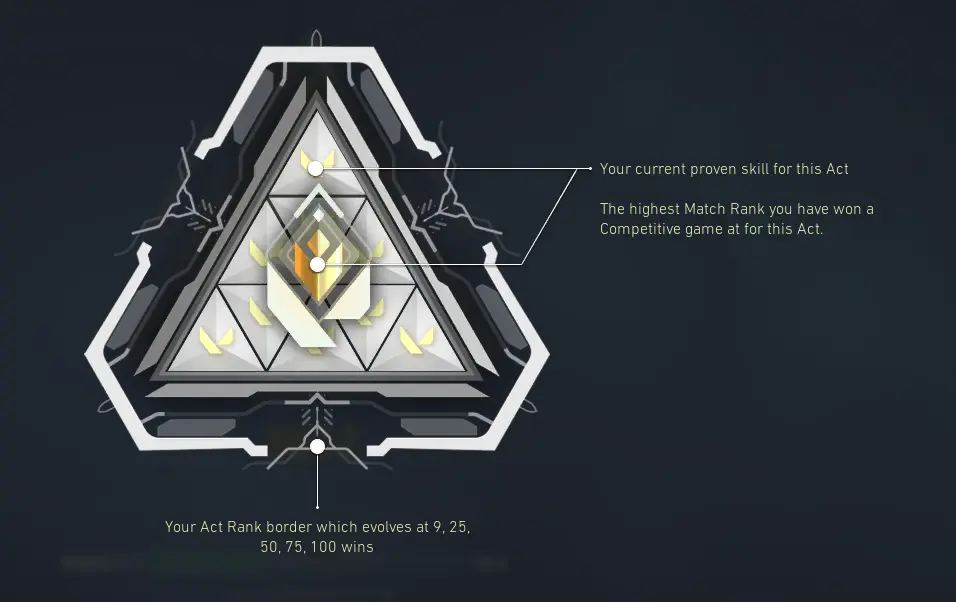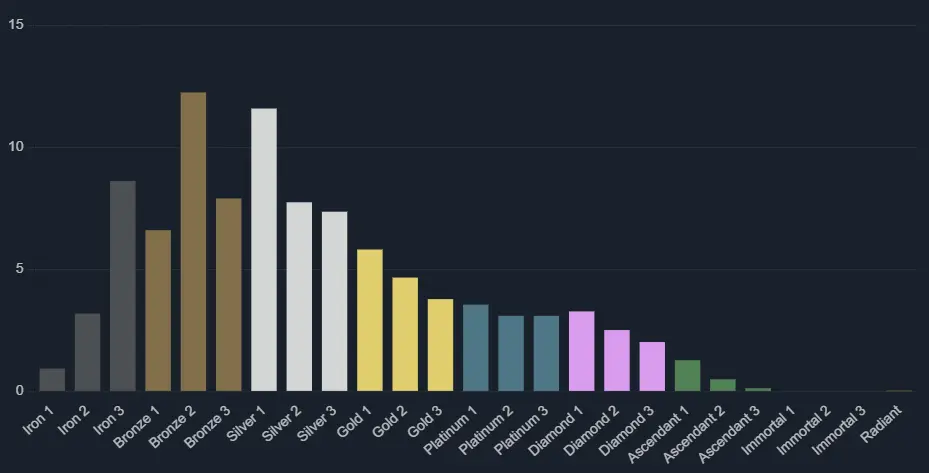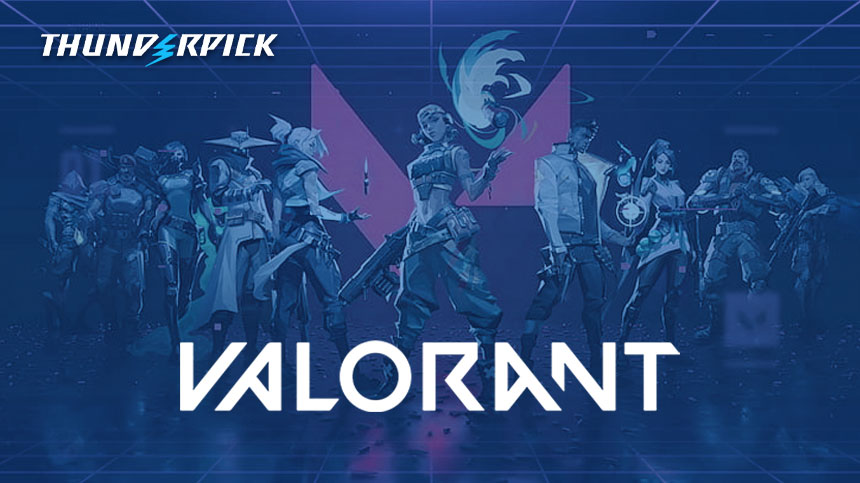Are you stuck in ELO hell? Here’s the good news: You can break free, and we can help. Whether you’re struggling to escape Silver or chasing Radiant, VALORANT’s ranked mode is where the real grind begins. Every match is a brutal test of skill, strategy, and mental toughness.
This guide breaks down everything about the VALORANT ranking system, including how to unlock competitive mode and the best strategies to help you rank up faster. We’ll also discuss act rank, rank decay, rank reset, and the latest rank distributions to assist your climb to the top!
Valorant Ranking System
How To Play VALORANT Ranked Mode
You can only play VALORANT’s Competitive mode after reaching Account Level 20. You can reach that level by earning XP in Unrated, Swiftplay, Spike Rush, Deathmatch, or Escalation matches. Completing Daily and Weekly Missions or playing with friends also awards bonus XP.
Here’s how to access ranked matchmaking in VALORANT:
- Launch VALORANT on your PC.
- Select “Play” from the main menu.
- Select the “Competitive” tab.
- Select “Start” to queue for competitive matches.
As a new player, you’ll begin as Unranked, but you’ll quickly earn a rank after completing five placement matches. Your performance in these games (wins, kills, and overall impact) will determine where you start on the ranking ladder, so it’s important to give it your all.
Note: The highest rank that returning players can achieve after placement is Ascendant 1. For new players with no ranked history, the highest achievable rank is typically Platinum 1.
How Many Rank Tiers Are There In VALORANT?
As of January 2025, there are nine rank tiers in VALORANT: Iron, Bronze, Silver, Gold, Platinum, Diamond, Ascendant, Immortal, and Radiant, each reflecting a player’s skill level based on their individual performance in competitive games.
The Iron to Immortal ranks are split into Tiers 1-3, with 3 being the highest rank within that tier. The only exception is Radiant, which is reserved for the top 500 players in each region (North America, Europe, Brazil, Latin America, Korea, Japan, Southeast Asia, and Oceania).

Here is a breakdown of every rank in VALORANT (from lowest to highest):
- Iron 1
- Iron 2
- Iron 3
- Bronze 1
- Bronze 2
- Bronze 3
- Silver 1
- Silver 2
- Silver 3
- Gold 1
- Gold 2
- Gold 3
- Platinum 1
- Platinum 2
- Platinum 3
- Diamond 1
- Diamond 2
- Diamond 3
- Ascendant 1
- Ascendant 2
- Ascendant 3
- Immortal 1
- Immortal 2
- Immortal 3
- Radiant
What Are The Differences Between All VALORANT Ranks?
Want to know what distinguishes an Ascendant player from a Radiant? The difference is more than just aim and mechanics! Let’s break down every rank in VALORANT and uncover what makes each tier unique.
Iron
Iron players are beginners with little to no familiarity with VALORANT’s mechanics. They struggle with aiming, crosshair placement, map awareness, and strategic decision-making. This bracket is the foundational stage for learning core concepts and skills.
Bronze
Bronze players have a slightly better understanding of core mechanics but lack consistency. While they may demonstrate flashes of brilliance, they struggle to land decent shots and fail to combo their abilities. These players are also plagued by poor positioning and bad team play.
Silver
Silver players have better aim and mechanical skills. They’re more consistent with shots and have a better grasp of map layouts and common strategies. A big difference is their game sense. They’re more tactical but still fail to position themselves correctly or execute good counterplays.
Gold
Gold players are beginning to think more strategically about the game. However, their overconfidence and occasional mechanical mishaps hold them back. These players execute most plays with solid efficacy, are less erratic, and have a better understanding of map control and positioning.
Platinum
Platinum players have perfected most skills required to be proficient in VALORANT. They thrive in high-pressure situations, value teamwork, and effectively execute complex setups, rotations, and counter-strategies. Most importantly, they stay composed and focused, even when facing setbacks.
Diamond
Diamond players have strong mechanical ability and game sense. What truly sets them apart from the lower ranks is their consistency. These players have improved adaptability and better coordination with teammates. The only caveat is they still tend to have “solo player” mindsets.
Ascendant
Ascendant players have mastered advanced gameplay elements. Their teamwork and coordination skills are well-developed thanks to their solid grasp of timings, rotations, and utility usage. While mistakes are rare, they can occur in complex setups. However, they’re quick to learn from these misplays.
Immortal
Immortal players have superior mechanical ability and a deep strategic understanding of the game. They boast superior adaptability, advanced utility and skill usage, and excellent teamwork. Mistakes are rare but decision-making under extreme pressure and minor misreads can still be exploited.
Radiant
Radiant players are characterized by nearly flawless gameplay. They have mastered VALORANT, boasting almost enviable mechanical and predictive skills, with the ability to counter even advanced strategies. They execute plays with little to no error and often compete at (or near) a professional level.
How Does The VALORANT Ranking System Work?
The ranking system in VALORANT uses two core metrics: (i) a hidden matchmaking rating (MMR) and (ii) a Rank Rating (RR). Both systems operate independently but work synergistically to determine rank progression.
The TLDR version is that MMR influences who you’re matched against, while RR tracks visible rank progression based on outcomes. Let’s break it down.
Rank Rating (RR)
RR is the point system that determines your competitive rank in VALORANT. It’s basically what moves you up or down the ranked tiers (e.g., from Diamond 1 to Diamond 2, etc.). For ranks below Immortal, you need 100 RR to rank up. If your RR drops below 0, you’ll be demoted.
RR gains and losses are primarily based on the match outcome, but the round differential also plays a role. Decisive wins usually grant more RR than close calls. You can expect to gain 5-50 RR for victories and lose 0-30 RR for defeats. In tied games, you may receive 0-20 RR.
Individual performance (like KDA and damage) impacts RR more for new accounts or during tied matches. However, in Immortal and Radiant ranks, personal stats no longer affect RR gains or losses. Instead, RR is closely tied to your MMR through a rank convergence system.
Matchmaking Rating (MMR)
MMR is a hidden value representing a player’s true skill level. It’s mainly used to ensure fair matchmaking by pairing similarly skilled players against each other. Nobody knows exactly how the MMR algorithm works but it’s affected by wins and losses, which raise and lower the number, respectively.
If your MMR is higher than your current rank, you’ll typically gain more RR for wins and less for losses, making your grind up the ranked ladder easier. However, if your MMR is lower than your current rank, you’ll gain less RR for wins and lose more for losses, making it harder to rank up.
Penalties
Ranked matches in VALORANT are a big deal, so it only makes sense that Riot punishes players who aren’t on their best behavior. Examples of bad behavior include repeated periods of inactivity, queue dodging (i.e., leaving a match during Agent Select), intentionally committing friendly fire, and toxicity. These will result in XP denial, RR penalties, teamplay restrictions, and, in severe cases, even permabans.
Does Your Rank Reset In VALORANT?
Yes, the rank resets. The VALORANT competitive season is split into Episodes (lasting roughly six months), each with three Acts (lasting roughly two months). A hard reset occurs at the start of a new Episode, requiring all players to recalibrate their ranks by playing five placement matches.
At the start of a new Act, a soft reset happens. However, players only need to play one placement match to recalibrate their rank. In both cases, your hidden MMR will carry over, resulting in only minor rank tier adjustments (most of the time).
Note: During Act resets, all Radiant players are demoted to Immortal. While they (together with Immortal players) will retain their spot on the leaderboard, their RR will be reduced by 90%.
Does VALORANT Have Rank Decay?
No, VALORANT doesn’t have traditional rank decay. Your visible rank will remain unchanged even during prolonged periods of inactivity. But there is a catch—your hidden MMR will still decrease over time, so you’re more likely to incur significant RR drops after lost matches.
The game also increases your MMR variance, causing you to be paired with a broader range of opponents to quickly recalibrate your skill when you return. While Riot Games hasn’t specified the length of inactivity that lasts for this adjustment, the impact is minimal.
Check out our detailed guide to learn more about rank decay in VALORANT.
What Is VALORANT Act Rank?
Your VALORANT Act Rank is a visual record of your peak performance or “proven skill.” It’s determined by the highest-ranked win you’ve accumulated during an Act. While it doesn’t impact matchmaking or gameplay, Act Rank serves as an indicator of your consistency and progress.
The Act Rank Badge is shaped like a pyramid filled with smaller triangles. Each triangle represents a ranked match win, with the triangle at the top reflecting your highest-ranked victory. As you continue to win matches at higher ranks, those wins will gradually replace lower-ranked victories.
The Act Rank Badge also has an evolving border that upgrades after 9, 25, 50, 75, and 100 ranked wins. A progress bar beneath the badge tracks the number of victories required to progress to the next border tier. When the Act ends, your final Act Rank Badge is displayed on your profile.

What Is The Latest VALORANT Rank Distribution?
According to Riot Games’ executive producer Anna Donlon, VALORANT has more than 35 million monthly players. Most of these players are concentrated in the lower ranks—Bronze (26.34%) and Silver (26.59%)—and make up more than 50% of the entire player base.
Players in higher ranks like Diamond (8.46%) and Ascendent (2.11%) are more exclusive, comprising a little over 10%, while those at the top of the competitive ladder—Immortal (0.04%) and Radiant (<0.01%)—are extremely rare, accounting for less than 0.05% of all players.
Here is the current rank distribution in VALORANT, accurate as of Jan. 10, 2025.
| Ranks | Percentage (%) |
| Iron 1 | 0.90% |
| Iron 2 | 3.11% |
| Iron 3 | 8.62% |
| Bronze 1 | 6.38% |
| Bronze 2 | 12.27% |
| Bronze 3 | 7.69% |
| Silver 1 | 11.73% |
| Silver 2 | 7.56% |
| Silver 3 | 7.31% |
| Gold 1 | 5.59% |
| Gold 2 | 4.55% |
| Gold 3 | 3.78% |
| Platinum 1 | 3.56% |
| Platinum 2 | 3.11% |
| Platinum 3 | 3.26% |
| Diamond 1 | 3.52% |
| Diamond 2 | 2.65% |
| Diamond 3 | 2.29% |
| Ascendant 1 | 1.51% |
| Ascendant 2 | 0.50% |
| Ascendant 3 | 0.09% |
| Immortal 1 | 0.02% |
| Immortal 2 | <0.01% |
| Immortal 3 | <0.01% |
| Radiant | <0.01% |
Note: These statistics represent the percentage of VALORANT players occupying each rank tier for Season 25, Act 1, as of Jan. 10, 2025. The data is sourced from vstats.gg and is derived from the official VALORANT API.

Which Ranks Can Play Together in VALORANT?
VALORANT has a ton of matchmaking rules to keep games balanced. In general, you can only queue with players 1 tier apart. For example, if you’re Silver, you can squad up with players as high as Gold. In 3-stacks, this rule applies to the highest-ranked player in the group.
The only exception is 5-stacks, which has no restrictions. The catch is that if your ranks are too spread out (or someone is Immortal), your RR gains will be cut by 25%. Is there a Radiant player in the mix? In that case, all non-Radiant players will get hit with a 90% RR penalty.
Here’s a full breakdown of the RR reduction for 5-stacks:
- 2-rank difference: 25% penalty
- 3-rank difference: 50% penalty
- 4-rank difference: 27% reduction
- 5-rank difference (or higher): 90% penalty
Unranked players still completing placement matches can join a party, but their previous Act’s rank(s) will determine who they’re eligible to queue with. Overall, these rules maintain the integrity of competitive play by preventing significant skill gaps within a team.
VALORANT Ranked Mode Party Restrictions
Here’s an overview of all party restrictions for 2- and 3-stacks in Competitive Mode:
| Rank | Permitted Ranks |
| Iron | Iron, Bronze, Silver |
| Bronze | Iron, Bronze, Silver |
| Silver | Iron, Bronze, Silver, Gold |
| Gold | Silver, Gold, Platinum |
| Platinum | Gold, Platinum, Diamond |
| Diamond | Platinum, Diamond, Ascendant |
| Ascendant | Diamond, Ascendant, Immortal |
| Immortal | Ascendant, Immortal, Radiant* |
| Radiant | Immortal, Radiant* |
Note: Radiant players can only queue with Immortal players if they are in a 2- or 5-Stack party.
How To Rank On Regional Leaderboards In VALORANT
You must be at least Immortal rank to appear on the regional leaderboards in VALORANT. You also need to meet all of these conditions:
- Play at least 50 competitive games during the Act.
- Play at least one competitive game within 7 days.
- Have an account in good standing (i.e., no bans or restrictions).
The leaderboard features the top 500 players in each region (based on RR), making it almost exclusively reserved for Radiant players. However, players who fail to meet these conditions are automatically removed from the rankings, allowing other Immortal or Radiant players to take their place.
How To Rank Up Fast In VALORANT – Our Top Tips
Climbing the ranked ladder isn’t easy, but there are some things you can do to speed up the process. Here are some quick tips to help you rank up in VALORANT, but be sure to check out our complete guide to climbing the ranks.
Master The Agents
Mastering a small pool of Agents can give you a huge edge by allowing you to make smarter, more impactful decisions in-game. Just ensure you learn their strengths and weaknesses to understand the limits of those characters in different setups. Better yet, consult tier lists to identify all the strongest Agents in the meta.
Don’t Overthink It
Overthinking makes you second-guess your decisions, which, in turn, creates new problems for your enemies to exploit. Mistakes like this are often punished at higher ranks, so it’s worth working on them early into your ranked journey. Instead, try to identify specific weaknesses and revisit the basics through consistent practice and self-review.
Study Map Layouts
This cannot be overstated: learn the maps! By studying the maps, you’ll know all the common angles, choke points, and rotation paths. This will then help you position better, predict enemy movements, and execute setups more effectively, whether you’re on the attack or defense.
Think you know VALORANT? Prove it on the Thunderpick VALORANT betting page and turn your skills into cash!Always practice Responsible Gambling and check out our latest promo offers and boosts. T&Cs apply. 18+ to play.

